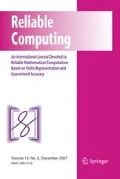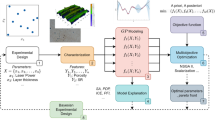Abstract
This paper discusses the use of an interval analysis based global optimization approach for the systematic design of ink cleaning solvent (commonly referred to as blanket washes) for lithographic printing. Very often the end-user (for example the printing press operator) has available to them blanket washes from different manufacturers. These blanket washes have to be mixed in different proportions (often by trial and error) until a blend is obtained that is suited to a particular cleaning operation. The trial and error approaches are costly, time-consuming and may not necessarily yield the solvent blend with the desired performance attributes. For example, the solvent blend may have a drying time that is too slow for the intended use. Another major performance objective is minimizing the effect of the solvent blend on the surface characteristics of the blanket. Surface characteristics of the blanket are affected through the swelling of the rubber blanket, which supports the printing paper. It should be noted that depending on the performance criteria and process constraints, a different solvent blend would be obtained. These criteria may vary according to the printer, the blanket wash sources, and whether or not the blanket wash blend would be dispensed by an automated process or by a manual process. Another thing to note is that in newspaper printing, the ink residue on the blanket has to be removed (using blanket wash) after the morning newspaper edition, in time for the afternoon or evening edition.
The simultaneous consideration of associated process constraints, property requirements, and environmental restrictions makes the blanket wash design a rather difficult problem. To address this, we present a framework for designing cleaning solvent blends that meet thermo-physical property requirements and environmental restrictions. The resulting mathematical program is a mixed-integer optimization problem involving (a) the selection of solvents from a set of pure component solvents (the discrete problem) and (b) finding the blend composition (the continuous problem).
The framework has been used to solve an industrially relevant problem of designing optimal blends for blanket wash applications in the printing industry taking into account solvent power, viscosity and surface tension.
Similar content being viewed by others
References
Barton, A. F.: CRC Handbook of Solubility Parameters and Other Cohesion Parameters, CRC Press, Boca Raton, Florida, 1985.
Bazaraa, M. S. and Shetty, C. M.: Nonlinear Programming, Wiley, New York, 1979.
Biegler, L. T. and Cuthrell, J. E.: Improved Infeasible Path Optimization for Sequential Modular Simulators—II: The Optimization Algorithm, Comp. & Chem. Eng. 9 (3) (1985), p. 257.
Biegler, L. T., Grossman, I. E., and Westerberg, A.W.: Systematic Methods of Chemical Process Design, Prentice Hall, Englewood Cliffs, 1997.
Duvedi, A. P. and Achenie, L. E. K.: On the Design of Environmentally Benign Refrigerant Mixtures: a Mathematical Programming Approach, Computers and Chemical Engineering 21(8) (1997), pp. 915–923.
Griewank, A., Judes, D., and Utke, J.: Algorithm 755: ADOL–C: A Package for the Automatic Differentiation of Algorithms Written in C/C++, ACM Transactions on Mathematical Software 22(2) (1996), pp. 131–167.
Hansen, E.: Global Optimization Using Interval Analysis, Marcel Dekker, New York, 1992.
Horvath, A. L.: Molecular Design, Elsevier, Amsterdam, 1992.
Ichida, K. and Fuji, Y.: An Interval Arithmetic Method to Global Optimization, Computing 23 (1979), p. 85.
Klein, J. A., Wu, D. T., and Gani, R.: Computer Aided Mixture Design with Specified Property Constraints, Comp. & Chem. Eng. Supplement 16 (1992), p. 229.
Moore, R. E.: Interval Analysis, Prentice Hall, Englewood Cliffs, 1966.
Moore, R. E.: Methods and Applications of Interval Analysis, SIAM, Philadelphia, 1979.
Moore, R. E., Hansen, E. R., and Lecrec, A.: Rigorous Methods for Global Optimization, in: Floudas, C. A. and Pardalos, M. (eds), Recent Advances in Global Optimization, Princeton University Press, 1992.
Ratschek, H. and Rokne, J.: Computer Methods for the Range of Functions, Halsted Press, New York, 1984.
Ratschek, H. and Rokne, J.: Interval Tools for Global Optimization, Computers Math. Applic. 21(6/7) (1991), pp. 41–50.
Reid, R. C., Prausnitz, J. M., and Poling, B. E.: The Properties of Gases and Liquids, McGraw Hill, New York, 1987.
Rokne, J. H.: Low Complexity k-Dimensional Centered Forms, Computing 37 (1986), pp. 247–253.
USEPA: Design for the Environment Program, in: Cleaner Technologies Substitute Assessment: Lithographic Blanket Washes, EPA 744–R–97–006, Washington, 1997.
Vaidyanathan, R. and El-Halwagi, M.: Global Optimization of Nonconvex Nonlinear Programs via Interval Analysis, Comp. & Chem. Eng. 18(10) (1994), pp. 889–897.
Van Iwaarden, R. J.: An Improved Unconstrained Global Optimization Algorithm, Ph.D., University of Colorado, Denver, 1996.
Author information
Authors and Affiliations
Rights and permissions
About this article
Cite this article
Achenie, L.E.K., Sinha, M. Interval Global Optimization in Solvent Design. Reliable Computing 9, 317–338 (2003). https://doi.org/10.1023/A:1025158512652
Issue Date:
DOI: https://doi.org/10.1023/A:1025158512652




